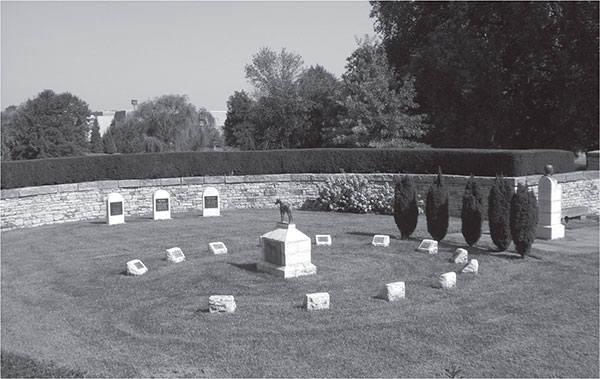
RESTING IN PEACE
What do you do when a famous horse dies? In Kentucky, you place it to rest in an equine cemetery. Thoroughbred Heritage lists almost 170 equine cemeteries in the commonwealth.84
The first Kentucky horse to have a grave marker was the thoroughbred Lexington. At his death in 1875, he was standing at stud at Woodburn Farm in Woodford County.85 Then owner Robert A. Alexander erected a marble stone to mark the grave. Others then followed the practice.86
Lexington was originally named Darley by Dr. Elisha Warfield at his farm The Meadows in Lexington when foaled in 1850. He was not raced until he was three, and then he bolted at the start and ran two miles before being brought back to the start. Even then, he led the field in each of two heats. This brought Lexington to the attention of Richard Ten Broeck, one of the owners of the Metairie Race Course in New Orleans, who bought the horse for $5,000 and renamed him.87 He won six of seven races and was second in the other, and he set the record time for four miles. When he started to go blind at age five, he was retired to stud at Nantura Stud in Midway, Kentucky, before being purchased two years later by Alexander.88
A few months after his burial, his body was exhumed and his skeleton came to be displayed in the Smithsonian in Washington, D.C. Finally, in 2010, his skeleton was returned home to Kentucky and is displayed at the International Museum of the Horse at the Kentucky Horse Park outside Lexington.89

Hamburg Place Equine Cemetery. Left: Grave marker for Merrick. Photographs by author.
Why all this attention for a horse who ran in only seven races? He led the sire list for sixteen years, two of them after his death.90 The sire list tracks the annual combined winnings of a stud’s offspring. This is a record that still stands. He sired at least 600 foals.91 Of these, 238 were winners; of them, 84 were graded stakes winners. Had not racing been interrupted in many places during the Civil War and many of his offspring used in cavalry units on both sides, these numbers would be greater.92
According to Thoroughbred Heritage, there are at least 165 equine cemeteries and graves in Kentucky.
One of the largest is on famous Calumet Farm outside Lexington, where, as of 2014, there were 63 gravestones. The stallion Bull Lea’s monument is centered in the tree-lined area. His seven winning colts are buried and marked in a semicircle in front of him. In another semicircle are his daughters, who produced Kentucky Derby winners. Other grave markers are to the left and right.93

Hamburg Place equine graveyard. Photograph by author.
Another famous equine cemetery, one easily accessed, as it is adjacent to a public street, is the Hamburg Place Cemetery. It is one of the oldest dedicated to horses. John E. Madden developed Hamburg Place farm starting with 235 acres he purchased in 1897 with the proceeds from selling the racehorse Hamburg, growing eventually to 2,300 contiguous acres.94 In all, eighteen horses are buried there.95 Beginning in 2005, the farm has since been developed commercially into a regional shopping center as well as residential, commercial and office areas. The streets in the development are all named after Hamburg Place horses; the relocated cemetery is on Sir Barton Way.
Another equine cemetery made the local news in 2017 when the owner of the farm, who knew of its equine cemetery, discovered an overgrown cemetery with graves tracing to Lexington’s earliest days. The horses buried there include the 1959 Kentucky Derby winner Tommy Lee.96